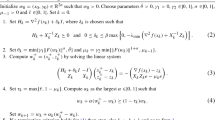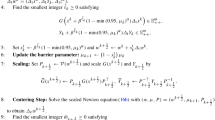Abstract
Recently studies of numerical methods for degenerate nonlinear optimization problems have been attracted much attention. Several authors have discussed convergence properties without the linear independence constraint qualification and/or the strict complementarity condition. In this paper, we are concerned with quadratic convergence property of a primal-dual interior point method, in which Newton’s method is applied to the barrier KKT conditions. We assume that the second order sufficient condition and the linear independence of gradients of equality constraints hold at the solution, and that there exists a solution that satisfies the strict complementarity condition, and that multiplier iterates generated by our method for inequality constraints are uniformly bounded, which relaxes the linear independence constraint qualification. Uniform boundedness of multiplier iterates is satisfied if the Mangasarian-Fromovitz constraint qualification is assumed, for example. By using the stability theorem by Hager and Gowda (1999), and Wright (2001), the distance from the current point to the solution set is related to the residual of the KKT conditions.
By controlling a barrier parameter and adopting a suitable line search procedure, we prove the quadratic convergence of the proposed algorithm.
Similar content being viewed by others
References
R.H. Byrd, G. Liu, and J. Nocedal, “On the local behaviour of an interior point method for nonlinear programming,” in Numerical Analysis 1997, D.F. Griffiths, D.J. Higham, and G.A. Watson (Eds.), Longman, 1998, pp. 37–56.
G.Di Pillo, S. Lucidi, and L. Palagi, “A superlinearly convergent primal-dual algorithm for constrained optimization problems with bounded variables,” Technical Report 02-99, Dipartimento di Informatica e Sistemistica, Universita di Roma “La Sapienza,” Roma, Italy, 1999.
A.S. El-Bakry, R.A. Tapia, T. Tsuchiya, and Y. Zhang, “On the formulation and theory of the Newton interior-point method for nonlinear programming,” Journal of Optimization Theory and Applications, vol. 89, pp. 507–541, 1996.
A.S. El-Bakry, R.A. Tapia, and Y. Zhang, “On the convergence rate of Newton interior-point methods in the absence of strict complementarity,” Computational Optimization and Applications, vol. 6, pp. 157–167, 1996.
J. Gauvin, “A necessary and sufficient regularity condition to have bounded multipliers in nonconvex programming,” Mathematical Programming, vol. 12, pp. 136–138, 1977.
W.W. Hager, “Stabilized sequential quadratic programming,” Computational Optimization and Applications, vol. 12, pp. 253–273, 1999.
W.W. Hager and M.S. Gowda, “Stability in the presence of degeneracy and error estimation,” Mathematical Programming, vol. 85, pp. 181–192, 1999.
M. Heinkenschloss, M. Ulbrich, and S. Ulbrich, “Superlinear and quadratic convergence of affine-scaling interior-point Newton methods for problems with simple bounds without strict complementarity assumption,” Mathematical Programming, vol. 86, pp. 615–635, 1999.
O.L. Mangasarian and S. Fromovitz, “The Fritz-John necessary optimality conditions in the presence of equality and inequality constraints,” Journal of Mathematical Analysis and Applications, vol. 17, pp. 37–47, 1967.
H.J. Martínez, Z. Parada, and R.A. Tapia, “On the characterization of Q-superlinear convergence of quasi-Newton interior-point methods for nonlinear programming,” Boletín de la Sociedad Matemática Mexicana, vol. 1, pp. 137–148, 1995.
R. Monteiro and S.J. Wright, “Local convergence of interior-point algorithms for degenerate monotone LCP,” Computational Optimization and Applications, vol. 3, pp. 131–155, 1994.
J.S. Pang, “Error bounds in mathematical programming,” Mathematical Programming, vol. 79, pp. 299–332, 1997.
D. Ralph and S.J. Wright, “Superlinear convergence of an interior-point method despite dependent constraints,” Mathematics of Operations Research, vol. 25, pp. 179–194, 2000.
L.N. Vicente and S.J. Wright, “Local convergence of a primal-dual method for degenerate nonlinear programming,” Computational Optimization and Applications, vol. 22, pp. 311–328, 2002.
S.J. Wright, “Modifying SQP for degenerate problems,” Technical Report ANL/MCS-P699-1097, Mathematics and Computer Science Division, Argonne National Laboratory, Illinois, USA, Oct. 1997.
S.J. Wright, “Superlinear convergence of a stabilized SQP method to a degenerate solution,” Computational Optimization and Applications, vol. 11, pp. 253–275, 1998.
S.J. Wright, “Effects of finite-precision arithmetic on interior-point methods for nonlinear programming,” SIAM Journal on Optimization, vol. 12, pp. 36–78, 2001.
S.J. Wright and D. Orban, “Properties of the log-barrier function on degenerate nonlinear problems,” Technical Report ANL/MCS-P772-0799, Mathematics and Computer Science Division, Argonne National Laboratory, Illinois, USA, Sept. 1999.
H. Yabe and H. Yamashita, “Q-superlinear convergence of primal-dual interior point quasi-Newton methods for constrained optimization,” Journal of the Operations Research Society of Japan, vol. 40, pp. 415–436, 1997.
H. Yamashita, “A globally convergent primal-dual interior point method for constrained optimization,” Optimization Methods and Software, vol. 10, pp. 443–469, 1998.
H. Yamashita and H. Yabe, “Superlinear and quadratic convergence of some primal-dual interior point methods for constrained optimization,” Mathematical Programming, vol. 75, pp. 377–397, 1996.
Author information
Authors and Affiliations
Corresponding author
Rights and permissions
About this article
Cite this article
Yamashita, H., Yabe, H. Quadratic Convergence of a Primal-Dual Interior Point Method for Degenerate Nonlinear Optimization Problems. Comput Optim Applic 31, 123–143 (2005). https://doi.org/10.1007/s10589-005-2177-x
Received:
Revised:
Accepted:
Issue Date:
DOI: https://doi.org/10.1007/s10589-005-2177-x




